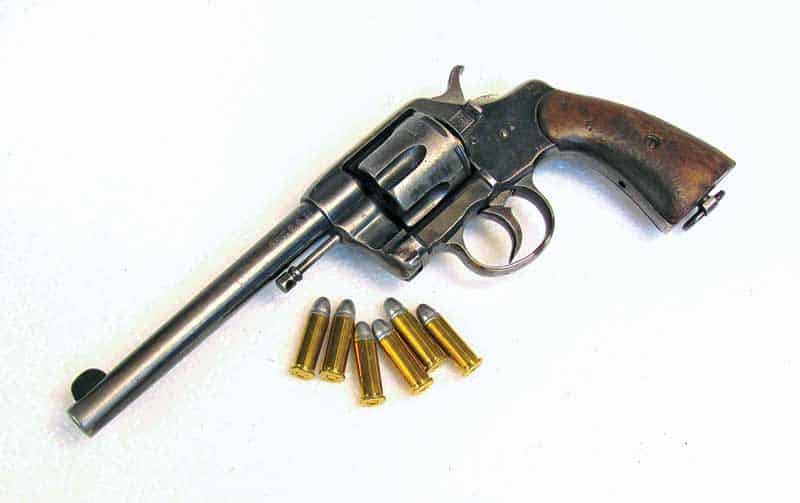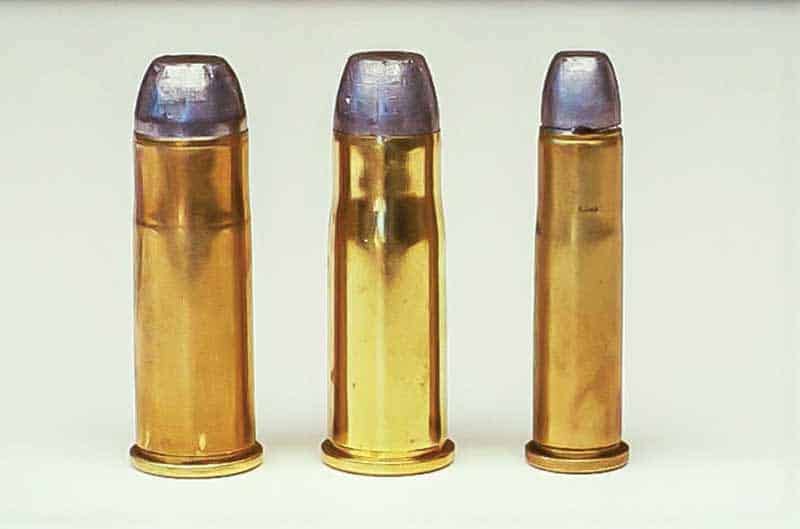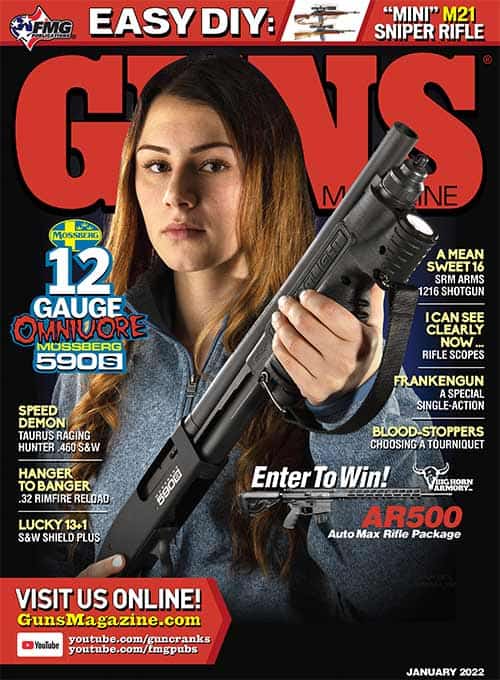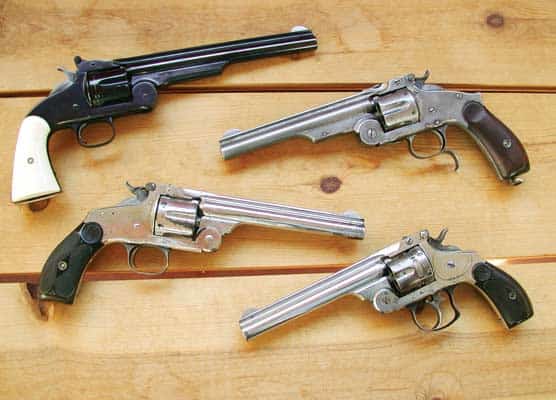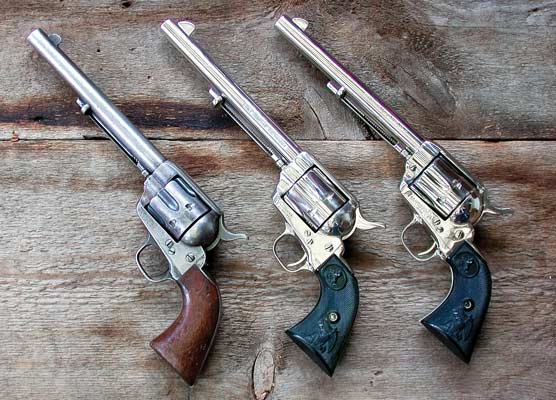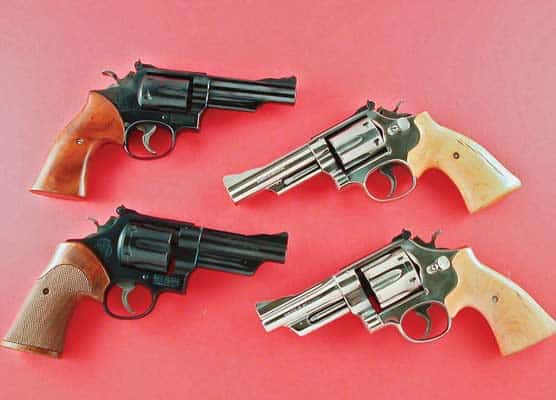Crazy Cartridge Confusion
“A rose by any other name …”
In the beginning, Oliver Winchester’s company brought forth the first really successful repeating firearm with the .44 Henry levergun. This rimfire cartridge was a true .44 —actually almost .45 — as it used a bullet with a diameter of 0.445″, the outside diameter of the cartridge case. This was accomplished by using a bullet that had a base of a smaller diameter than the rest of the case and this smaller-diameter “heel” fitted inside the cartridge case. When Smith & Wesson brought out the first big-bore cartridge-firing sixgun in late 1869, they followed the same pattern using a bullet with two diameters, a smaller heel and the main part of the bullet being 0.441″. Then along came the Russians.
Smith & Wesson received a large order from the Russian military for their S&W American Model #3 revolver, however, the Russians made two significant changes. One was for the revolver itself changing the grip frame by adding a hump to the top of the curved backstrap and also placing a spur on the bottom of the trigger guard. To this day there is still no common agreement on the purpose of this spur. Was it to give a more solid grip or simply to keep the pistol from sliding down when placed in a sash at the waistband?
The more important change was the cartridge — the Russians wanted a bullet of uniform diameter. When the bullet was fashioned to fit inside the case (the normal way today), the bullet diameter was shrunk to a standard 0.429″. This has been the case ever since with the ensuing .44 Special, simply a longer .44 Russian, and the .44 Magnum which came about by lengthening the .44 Special case.
Here is also a good spot for making another correction of misinformation both I and others have been guilty of in the past. We gave the Russians credit for coming up with the inside lubricated bullet, that is, a bullet with the lube grooves inside the case. This is not true as the original .44 Russian rounds still used an outside lubricated bullet until 1887 when the Union Metallic Cartridge Company began placing the lube grooves of the .44 Russian cartridge inside the case.
We can purchase sixguns today chambered in .44 Colt but these also have been changed from the original. Colt’s first .44 also used a heeled bullet, however, today’s .44 Colt cartridge is simply the .44 Special shortened and with a smaller rim diameter. The latter was done to fit the first replica sixguns which had cylinders too small in diameter to accept six .44 Russian or .44 Special whose rims would overlap. Today’s .44 Colt replicas, at least some of them, have larger diameter cylinders to also accept .44 Russian and some are also chambered to accept all three of these .44 cartridges.
Dash-Something
Many of the rifle cartridges of the 19th century were hyphenated, consisting of two numbers with the first one giving the bullet diameter while the latter was for the powder charge. For example, we have the .45-70 which used a bullet of 0.457″ to 0.459″ diameter over 70 grains of black powder. Notice .45 rifles are actually closer to .46 caliber. Other rifle .45 caliber nomenclature included such as the .45-60, .45-75 .45-90, .45-100, .45-110 and .45-120 with the second number in each case denoting the charge of black powder under the bullet. Then came the Winchester Model 1894 and more confusion.
This now-legendary levergun was first chambered in .38-55 and .32-40, which both follow the original nomenclature pattern. Then in 1895 the first smokeless cartridge arrived in the 1894, the .30 Winchester Centerfire (or .30 WCF) that is now mostly known as the .30-30, the second number having nothing to do with a black powder charge. About 10 years later saw the arrival of first the .30-03 and then the .30-06 with the second numbers having absolutely nothing to do with powder charges but rather the year they were introduced. The .308 Winchester of the 1950s actually was named for the bullet diameter.
Winchester’s original centerfire cartridges for the Model 1873 levergun were the .44 WCF, .38 WCF and .32 WCF. Today these are more commonly known as .44-40, .38-40 and .32-20. The prevailing wisdom is Marlin started this difference in naming the cartridges because they did not want to write “Winchester” on their barrels so the .44 Winchester Centerfire became the .44-40 with the second number denoting the number of grains of black powder. The .32-20 , actually a .31, was loaded with 20 grains of black powder but what of the .38-40? The actual bullet diameter is not 0.38″ but rather 0.401″. There are some who say it actually was a .40-38, however .38-40 sounded better and then there would be the confusion if it was called a .40-40. Perhaps we shall never know. Even more confusing is a so-called .41 Long Colt which uses not a 0.410″ bullet as the later arriving .41 Magnum, but actually a 0.386″ diameter bullet. And both the .38-40 and .41 Long Colt sixguns produced by Colt had a barrel groove diameter of 0.401″ with the latter cartridge designed so the smaller bullet would expand to match the barrel.
The .38 Saga
When Smith & Wesson introduced a new cartridge in their M&P about the time the 19th century was becoming the 20th century, they called this new cartridge the .38 Smith & Wesson Special, whereas the .38-40 was actually larger in size than the .38, the .38 Special is smaller than .38. There seems to be no end to the confusion. How is it the .38 Special can be fired in a sixgun chambered for .357 Magnum? The answer is the latter is named for the actual bullet diameter used while the .38 Special, although it actually uses the same bullet diameter as the Magnum, is mis-named. Just before the .357 Magnum arrived in 1935, Colt brought out the .38 Super which is also not a true .38 but actually uses bullets of 0.355″ to 0.356″ diameter. So all of these are actually .36 caliber.
Another cartridge surrounded by confusion is the .38 Colt, both the Long and Short of it. I as well as several others have assumed the .38 Short Colt came first followed by the .38 Long Colt. The latter will always be remembered for its failures rather than its successes. When the United States military switched from percussion pistols, they adopted the Smith & Wesson American .44 in the early 1870s and the Smith & Wesson Schofield .45 in 1875; however both were short-lived and the .45 Colt Single Action Army of 1873 was the official sidearm until the 1890s. Colt had introduced the .38 Long Colt for use in their smaller centerfire New Line Revolvers in 1874 and then brought out their first double-action sixgun, the Model of 1877 or as it is more well-known, the Lightning. In 1889 the United States Navy adopted the .38 Colt New Navy Double Action Revolver as its official sidearm and then the Army followed adopting the Model of 1892. This turned out to be one of the worst disasters as far as adopting military cartridge in United States history.
The cartridge, which was weaker than the .38 Special which soon followed, failed miserably in the Philippine campaign. So much in fact the .45 Colt Single Action Army was removed from storage and shipped to the Philippines for use. This turned out to actually be a good thing as it led to the adoption of the .45 Government Model of 1911.
So the .38 Long Colt actually arrived before the .38 Short Colt and to make it even more confusing, we have the .38 Short Colt (Short Case) and the .38 Long Colt (Long Case). The latter also originated about 1874 and was chambered in the Colt New Line Revolver. The former, which we would expect to be the forerunner of all of this, actually was the last to appear, being brought out by Remington-Peters in the 1920s.
I started this piece with the idea of clearing up some confusion. I hope I haven’t just done more to muddy the waters.

Get More Revolver Content Every Week!
Sign up for the Wheelgun Wednesday newsletter here:
